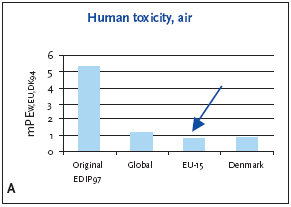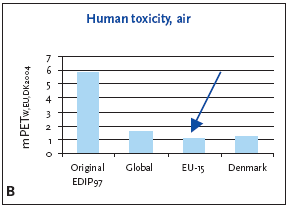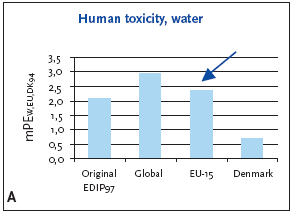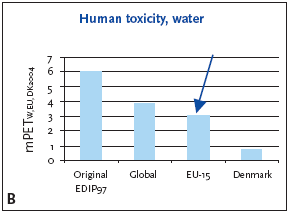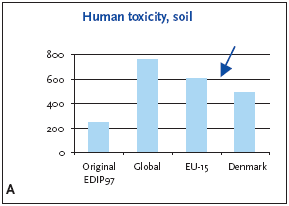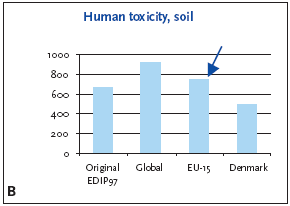|
Impact categories, normalisation and weighting in LCA 9. Human toxicity
Human toxicity - in LCA context - covers a number of different effects: acute toxicity, irritation/corrosive effects, allergenic effects, irreversible damage/organ damage, genotoxicity, carcinogenic effects, toxicity to reproductive system/teratogenic effects, and neurotoxicity in a single parameter (toxic equivalency factors, EF). The equivalence factors are determined for emission to different compartments: air, water, and soil and exposure via different media: air water, and soil. Human toxicity does not include indoor consumer exposure or work environment. 9.1 Substances contributing to the impact categoryThe substances contributing to human toxicity are numerous and cannot be described by even a finite number of groups. In the calculation of the normalisation references for human toxicity, it has thus been the ambition to find the right order of magnitude. We know that not all activities have been included and therefore the references are expected to be on the low side but they are believed to have the right order of magnitude. The normalisation references for human toxicity include impacts from:
9.2 Human toxicity potentialIn EDIP (Hauschild et al., 1998), the potential human toxicological effects are expressed as critical volume i.e. the volume of a certain media required to absorb a specific emission without resulting in adverse effects. The toxicity potentials are expressed by the following units, referring to the media by which humans are exposed to different substances:
When using this methodology toxic potentials for all kind of substances can be aggregated to a single value i.e. a critical volume of air, water or soil for each component. Toxic equivalence factors (EF) for a number of substances as well as the methodology for calculating EF for other substances can be found in Hauschild et al. (1998). 9.3 Normalisation reference and weighting factor for human toxicityThe normalisation references and weighting factors for human toxicity are calculated according to the general formula in chapter 1, Introduction. Normalisation and weighting factors for human toxicity are presented in Table 9.1. Details on determining normalisation references and weighting factors can be found in Christensen and Hoffmann (2003) and Busch (2003) respectively. Table 9.1 Normalisation references and weighting factors for human toxicity (exposure via air, water and soil) (Christensen & Hoffmann 2003; Busch 2003).
1 Weighting factors have only been established for human toxicity via soil for Europe; the European weighting factor is recommended as default value for impact potentials located in Denmark. 2 Weighting factors have not been established worldwide; the European weighting factors are recommended for impact potentials located outside Europe or at unknown locality. Human toxicity is considered as a local as well as a regional impact. The EU- 15 normalisation references and the weighting factor of EU-15 are in general recommended for impact potentials in Denmark as well as Europe. A possible exception is when the (main) impacts are known to take place in Denmark, e.g. as a result of emissions from specific point sources. In this case, use of Danish normalisation references and weighting factors is recommended. If the location is unknown or outside Europe the global normalisation reference is recommended. It should be noted that the weighting factors for all areas are low, because of lack of specific reduction targets. An international agreement on specific reduction targets or total phase-out of substances like persistent organic pollutants and heavy metals would increase the weighting factor significantly. 9.4 Example of applying normalisation reference and weighting for human toxicityFigure 9.1 - Figure 9.3 illustrate the normalised and weighted human toxicity potentials, using the EU-15 normalisation references combined with the EU- 15 weighting factors as recommended. Based on impact potentials for human toxicity for the product in question the resulting normalised and weighted values are: Human toxicity via air: Human toxicity via water: Human toxicity via soil: Figure 9.1 Normalised (A) and weighted (B) human toxicity potentials, exposure by air for production of a refrigerator at different localities
Figure 9.2 Normalised (A) and weighted (B) human toxicity potentials, exposure by water for production of a refrigerator at different localities.
Figure 9.3 Normalised (A) and weighted (B) human toxicity potential, exposure via soil for production of a refrigerator at different localities.
The figures illustrate that there is a relatively large variation in the toxicity potentials, depending on the chosen normalisation reference. This finding calls for a sensitivity analysis, using other normalisation references and weighting factors, examining the reason for the differences in more detail, and relating them to the environmental conditions on the affected market. Of special interest is perhaps to find a balance between toxicity to air and water, respectively, as the results in these categories point in opposite directions. It should, however, be noticed that the significant decrease in importance in comparison with the original EDIP calculations is due to an increased normalisation factor including the contribution from nmVOC from road transport. This contribution is not included in the calculation of the impact potential. 9.5 If you would like to know moreBusch, N.J. 2005. Calculation of weighting factors. In Stranddorf, H.K., Hoffmann, L. & Schmidt, A. Update on impact categories, normalisation and weighting in LCA. Environmental Project no. 995, Danish EPA, 2005. Christensen, F.M. & Hoffmann, L. 2005. Human toxicity. In Stranddorf, H.K., Hoffmann, L. & Schmidt, A. Update on impact categories, normalisation and weighting in LCA. Environmental Project no. 995, Danish EPA, 2005. EC- TGD 1996, Technical guidance documents in support of commission directive 93/67/EEC on risk assessment for new notified substances and commission regulation (EC) No1488/94 on risk assessment for existing substances (Parts I, II, III and IV). Office for Official Publications of the European Community, Luxembourg. EEA 1998a, Europe's Environment:The Second Assessment. Eurostat, European Commission, European Environment Agency. Office for Official Publications of the European Commission, Luxembourg. EEA 1998b,. Europe's Environment: statistical compendium for the Second Assessment. Eurostat, European Commission, European Environment Agency. Office for Official Publications of the European Commission, Luxembourg. EU 1998, Commission Directive 98/98/EC of 15 December 1998 adapting to technical progress for the 25 time Council Directive 67/548/EEC on the approximation of the laws, regulations and administrative provisions relating to the classification, packaging and labelling of dangerous substances. Available at http://europe.eu.int. Hauschild, M.Z., Olsen, S.I. & Wenzel, H. 1996, Toksicitet for mennesker i miljøet som vurderingskriterium ved miljøvurdering af produkter, i Hauschild, M.Z. (ed.), Baggrund for miljøvurdering af produkter. Miljø- og Energiministeriet, Dansk Industri. København. (in Danish) Hauschild, M.Z., Olsen, S.I. & Wenzel, H. 1998, "Human toxicity as a criterion in the environmental assessment of products", in Environmental assessment of products.Volume 2: Scientific background, eds. Hauschild, M.Z. & Wenzel, H., Chapman & Hall, London.
|
